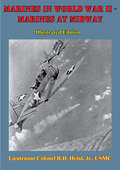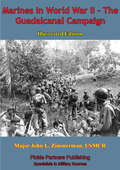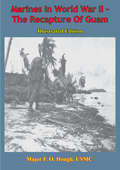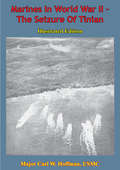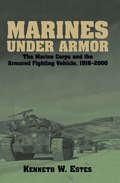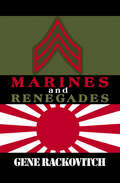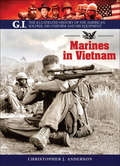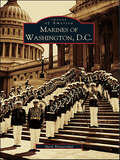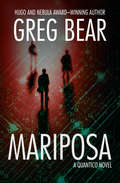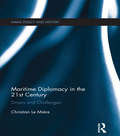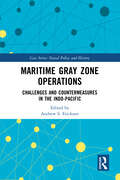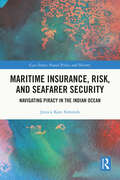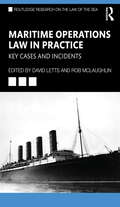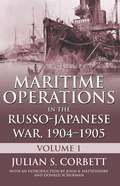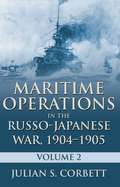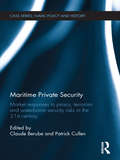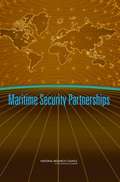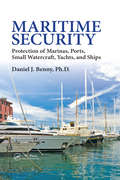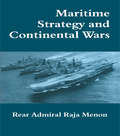- Table View
- List View
Marines In World War II - The Defense Of Wake [Illustrated Edition]
by Lieutenant Colonel R.D. Heinl Jr. USMC General A. A. Vandegrift USMCContains 23 photos and 8 maps and charts.The story of the immortal heroic defence of the American outpost on Wake Island by a handful of marines and civilians against an overwhelming forces of the Japanese."During December 1941, the stubborn defense of Wake by less than 450 Marines galvanized not only the American public but their comrades in arms. In days of disaster then, as of uncertainty later, the thought of Wake and its defenders encouraged Marines to hang on longer, and to fight more resolutely. Small in time and numbers though the action was by comparison with Guadalcanal or the other great battles to come, Wake will never be forgotten."To my mind, in addition to the obvious military lessons which may be drawn from any battle, be it victory or defeat, the defense of Wake points up two soldierly characteristics which may well be remembered by Marines. These are military adaptability, and the realization that, first and always one must be prepared to face ultimate close ground combat with the enemy."The officers and men of the 1st Defense Battalion on Wake were artillerymen of a highly specialized type; those of VMF-211 were aviation technicians. neither group let its specialized training or background prevent it from fighting courageously and well as basic infantry when the chips were down. Despite its specialization, each group did the best it could with what it had."These capabilities and attributes, I submit, should characterize Marines now as they characterized those Marines on Wake, who, though they were outnumbers and eventually overwhelmed, were never outfought.-A.A. VANDEGRIFT, General, U.S. Marine Corps"
Marines In World War II - The Guadalcanal Campaign [Illustrated Edition]
by General A. A. Vandegrift USMC Major John L. Zimmerman USMCRContains 88 photos illustrations and maps."We struck at Guadalcanal to halt the advance of the Japanese. We did not know how strong he was, nor did we know his plans. We knew only that he was moving down the island chain and that he had to be stopped.We were as well trained and as well armed as time and our peacetime experience allowed us to be. We needed combat to tell us how effective our training, our doctrines, and our weapons had been.We tested them against the enemy, and we found that they worked. From that moment in 1942, the tide turned, and the Japanese never again advanced.-A.A. Vandergrift, General U.S. Marine Corps"Major John L. Zimmerman, USMCR
Marines In World War II - The Marshalls: Increasing The Tempo [Illustrated Edition]
by Lieutenant Colonel R.D. Heinl Jr. USMC General Lemuel C. Shepherd USMC Lieutenant Colonel John A. CrownThis book tells the story of the Marines spearheading the thrust through the Japanese outer ring of defences and recounts the brutal and important island-hopping Pacific campaign at its most gripping following the bloodbath at Tarawa.Contains 97 photos and 16 maps and charts.“As 1943 drew to a close, Marines had retaken Tarawa and portions of the Solomons from the Japanese invader, but the formidable enemy bases studding the vast Pacific, bases which had been built during the preceding 25 years, were as yet untouched by our amphibious forces.In early 1944 the first penetration of this prewar enemy territory was accomplished with the assault and occupation of Kwajalein and Majuro Atolls in the Marshall Islands. These were quickly followed by the seizure of Eniwetok Atoll. The major role in these over-all operations was undertaken by Marine units working in close coordination with elements of the Army, Navy, and Coast Guard. That they acquitted themselves with distinction is reflected in the rapidity with which they accomplished their missions. Operations in the Marshall Islands clearly indicated that Japanese bases in the Central Pacific could be by-passed. The way was now open for the neutralization of Truk and the assault on the Marianas, the next great step in the drive toward Japan.”-LEMUEL C. SHEPHERD, JR., GENERAL, U. S. MARINE CORPS, COMMANDANT OF THE MARINE CORPS
Marines In World War II - The Recapture Of Guam [Illustrated Edition]
by USMC General Lemuel C. Shepherd USMC Major O.R. LodgeSet in the Marianas group of islands is the American possession of Guam, U.S. territory since 1898; it was the captured by the Japanese soon after the infamous attack on Pearl Harbor and served as a symbol of the Japanese expansion. The American Forces sailed into view of Guam in 1944 determined to recapture the island for strategic and political purposes, but knew that the Japanese defenders take a heavy toll of them from their prepared positions. The story of the capture of the island is an epic of courage, bloodshed, fierce resistance by the Japanese and the indomitable will to conquer of the U.S. Marines.Contains 99 photos and 32 maps and charts."I have always had a feeling of deep satisfaction in having been the commander of one of the assault elements that returned the American flag to Guam. The island once more stands ready to fulfill its destiny as an American fortress in the Pacific.The conquest of Guam was a decisive triumph of combined arms over a formidable Japanese defensive force which took full advantage of the island's rugged terrain.The heroic action of the veteran Marines who seized Orote Peninsula and Apra Harbor gave the Navy a much-needed advance base for further operations in the Pacific. Once marine and Army units captured northern Guam, engineers moved in and out from the jungle the airfields from which the Twentieth Air Force launched B-29 raids, bringing the full realization of war to the Japanese homeland."-LEMUEL C. SHEPHERD, JR., GENERAL, U. S. MARINE CORPS, COMMANDANT OF THE MARINE CORPS
Marines In World War II - The Seizure Of Tinian [Illustrated Edition]
by General C. B. Cates USMC Major Carl W. Hoffman USMCDuring the Second World War the American forces in the Pacific engaged in the greatest series of amphibious assaults ever known against tenacious Japanese foe. Many of the assaults turned into brutal bloody encounters, marred often by a lack of experience in these difficult operations against extensive prepared positions; Tinian proved to be the most successful of all of the seaborne operations of the Pacific War.Contains 66 photos and 13 maps and charts.“TINIAN is a small island. In 1944 it was held by only 9,000 Japanese. Yet it was so well defended by nature against an amphibious operation that it might have proved a formidable and costly barrier to the final conquest of the Marianas. It had only one beach area suitable-by previous standards-for a major amphibious landing and that beach was heavily mined and skillfully defended.“The enemy, although long alerted to our intentions to attack Tinian, was tactically surprised when we avoided his prepared defenses and landed on two small beaches totalling in width only about 220 yards. Before he could recover from the shock, he was out-numbered and out-equipped on his own island. His subsequent effort to throw us into the water resulted in complete failure. We then pushed the length of the island in nine days, while suffering casualties light in comparison with those of most other island conquests.“As a participant in the operation, I naturally take pride in this achievement, as well as in Admiral Raymond A. Spruance’s evaluation: "In my opinion, the Tinian operation was probably the most brilliantly conceived and executed amphibious operation in World War II."”-C. B. CATES, GENERAL, U. S. MARINE CORPS, COMMANDANT OF THE MARINE CORPS
Marines Under Armor
by Kenneth EstesIn this story of men, machines and missions, Kenneth Estes tells how the U.S. Marine Corps came to acquire the armored fighting vehicle and what it tried to do with it. The longtime Marine tank officer and noted military historian offers an insider's view of the Corps's acquisition and use of armored fighting vehicles over the course of several generations, a view that illustrates the characteristics of the Corps as a military institution and of the men who have guided its development. His book examines the planning, acquisition, and employment of tanks, amphibian tractors, and armored cars and explores the ideas that led to the fielding of these weapons systems along with the doctrines and tactics intended for them, and their actual use in combat.Drawing on archival resources previously untouched by researchers and interviews of both past and serving crewmen, Estes presents a unique and unheralded story that is filled with new information and analysis of the armored vehicles, their leaders, and the men who drove these steel chariots into battle. Such authoritative detail and documentation of the decisions to acquire, develop, and organize armored units in the U.S. Marine Corps assures the book's acknowledgement as a definitive reference.
Marines and Renegades
by Gene RackovitchIn December 1945, two Japanese soldiers on Guam attempted to surrender to a patrol of US Marines. The marines, assuming them to be armed, shot and killed them. Another Japanese soldier witnessed the incident from the jungle. He fled, and his previous assessment of the treacherous Americans was enhanced. His zeal for retribution became ingrained in his psyche. In September 1946, four marines on a routine patrol on Guam seek renegade Japanese who had been stealing from the outlying villages. They're ambushed, and among the fighters is the zealous Japanese soldier. The incident brings about a chain of events that leaves the reader wondering . . . who are the true renegades? The marines or the Japanese?
Marines in Vietnam: The Illustrated History of the American Soldier, His Uniform and His Equipment (G.I. #Vol. 28)
by Christopher J. AndersonThis illustrated series presents the uniforms and equipment of the United States Army from the nineteenth century to the present day. Each volume combines detailed and informative captions with over 100 rare and unusual images. These books are a must for anyone interested in American military uniforms and the history of the United States Army.On the morning of March 8th, 1965, the men of the United States Marine Corps prepared to land on Red Beach II in the Republic of Vietnam. The resulting conflict became the most protracted war of the Corps' history. The Marines evolved through early, nervous attempts to fend off the North Vietnamese enemy, to 'hearts and minds' programmes with the local population, and the larger operations Hastings and Dewey Canyon, where fighting resembled some of the worst in the Pacific arena of World War II. This illustrated guide brings together more than 100 rare and unusual photographs to demonstrate the uniforms, insignia and equipment of the U.S.M.C., including the M14 rifle (later replaced by the M16); grenades, mines and flamethrowers; body armor flak jackets, helmets, camouflage and jungle boots; and transports such as the LVTP-5, Sea Knight and Chinook.
Marines in the Garden of Eden
by Richard LowryOn March 23, 2003, in the city of An Nasiriyah, Iraq, members of the 507th Maintenance Company came under attack from Iraqi forces who killed or wounded twenty-one soldiers and took six prisoners, including Private Jessica Lynch. For the next week, An Nasiriyah rocked with battle as the marines of Task Force Tarawa fought Saddam's fanatical followers, street by street and building to building, ultimately rescuing Private Lynch.
Marines of Washington D.C. (Images of America)
by Mark BlumenthalMarines of Washington, D.C. takes the reader on a visual tour that explores the dynamic history of the United States Marine Corps in the nation's capital. The Marines have played an integral role in the development of the social, structural, and political landscape of Washington for over 200 years. This volume traces the history of the Marines from the founding of the "Oldest Post of the Corps," Marine Barracks Washington in 1801, to participation in the War of 1812, the Civil War, the World Wars, and into the modern day. Explore the lasting impact of famous Marines, including Commandant Archibald Henderson, Marine Band Director John Phillip Sousa, and Commandants Alfred M. Grey and John A. Lejeune. Marines of Washington, D.C. highlights the unique relationship between the Marines of the nation's capital, the President, and the citizens of the United States they serve.
Marion Lane and the Deadly Rose
by T. A. WillbergThe second installment in the Marion Lane mysteries series. <p><p>The envelope was tied with three delicate silk ribbons: "One of the new recruits is not to be trusted..." <p><p>It's 1959 and a new killer haunts the streets of London, having baffled Scotland Yard. The newspapers call him The Florist because of the rose he brands on his victims. The police have turned yet again to the Inquirers at Miss Brickett's for assistance, and second year Marion Lane is assigned the case. But she's already dealing with a mystery of her own, having received an unsigned letter warning her that one of the three new recruits should not be trusted. She dismisses the letter at first, focusing on The Florist case, but her informer seems to be one step ahead, predicting what will happen before it does. <p><p>But when a fellow second-year Inquirer is murdered, Marion takes matters into her own hands and must come face-to-face with her informer-who predicted the murder-to find out everything they know. Until then, no one at Miss Brickett's is safe and everyone is a suspect. <p><p>With brilliant twists and endless suspense, all set within the dazzling walls and hidden passageways of Miss Brickett's, Marion Lane and the Deadly Rose is a deliciously fun new historical mystery you won't be able to put down.
Marion Lane and the Deadly Rose
by T.A. WillbergThe second instalment in the Marion Lane mysteries series. The envelope was tied with three delicate silk ribbons: "One of the new recruits is not to be trusted..."It's 1959 and a new killer haunts the streets of London, having baffled Scotland Yard. The newspapers call him The Florist because of the rose he brands on his victims. The police have turned yet again to the Inquirers at Miss Brickett's for assistance, and second year Marion Lane is assigned the case. But she's already dealing with a mystery of her own, having received an unsigned letter warning her that one of the three new recruits should not be trusted. She dismisses the letter at first, focusing on The Florist case, but her informer seems to be one step ahead, predicting what will happen before it does. But when a fellow second-year Inquirer is murdered, Marion takes matters into her own hands and must come face-to-face with her informer-who predicted the murder-to find out everything they know. Until then, no one at Miss Brickett's is safe and everyone is a suspect. With brilliant twists and endless suspense, all set within the dazzling walls and hidden passageways of Miss Brickett's, Marion Lane and the Deadly Rose is a deliciously fun new historical mystery you won't be able to put down. 'The most fun I've had with a book this year. Every page is a delight' Stuart Turton, author of The Seven Deaths of Evelyn Hardcastle
Mariposa (Quantico #2)
by Greg BearThe world just keeps getting tougher and more complicated. America teeters on the edge of bankruptcy because of crushing foreign debt and an apparent savior, The Talos Corporation, delivers training for soldiers and security forces around the world, logistical support and badly-needed troops economically, but with a hidden cost that&’s both sinister and disturbing.The three rookie FBI agents who survived the challenges portrayed in Quantico, have gone their separate ways but seem fated to be drawn back together in an alliance against a surprising challenge for which no one seems prepared. Rebecca Rose is brought back from an extended sabbatical when the President is shot and her second-in-command is implicated in an horrific crime—and all the threads point deeper into Talos&’s secretive activities. Fouad Al-Husam, working undercover inside Talos, has uncovered and been forced to hide vital information of a takeover plot that threatens America&’s independence.Nathan Trace, victim of a violent incident in the Middle East, struggles with post-traumatic stress and seems to be recovering through participation in a treatment program, code-named Mariposa, which has unexpected side-effects that turn patients into brilliant, detached and sociopathic individuals—very smart and extremely deadly.Only a desperate combination of misfits and survivors can combat an apparently inevitable collapse of American organization that will lead to the fall of democracy.
Mariposa (Quantico #2)
by Greg BearThe world just keeps getting tougher and more complicated. America teeters on the edge of bankruptcy because of crushing foreign debt and an apparent savior, The Talos Corporation, delivers training for soldiers and security forces around the world, logistical support and badly-needed troops economically, but with a hidden cost that&’s both sinister and disturbing.The three rookie FBI agents who survived the challenges portrayed in Quantico, have gone their separate ways but seem fated to be drawn back together in an alliance against a surprising challenge for which no one seems prepared. Rebecca Rose is brought back from an extended sabbatical when the President is shot and her second-in-command is implicated in an horrific crime—and all the threads point deeper into Talos&’s secretive activities. Fouad Al-Husam, working undercover inside Talos, has uncovered and been forced to hide vital information of a takeover plot that threatens America&’s independence.Nathan Trace, victim of a violent incident in the Middle East, struggles with post-traumatic stress and seems to be recovering through participation in a treatment program, code-named Mariposa, which has unexpected side-effects that turn patients into brilliant, detached and sociopathic individuals—very smart and extremely deadly.Only a desperate combination of misfits and survivors can combat an apparently inevitable collapse of American organization that will lead to the fall of democracy.
Mariquita—Revisited
by Chris Perez HowardMariquita, first published in 1982, has become the most widely read novel about the CHamoru experience during World War II on Guam. In the book, author Chris Perez Howard chronicles his mother's vibrant life before the War, her enduring strength during the Japanese occupation of the island, and her tragic death at the end of it. In this updated edition of the classic, Perez Howard revisits the story and adds more details, photos, and letters. It is a continuing tribute to his mother whose legacy lives on in the memories of all who read it.
Maritime Diplomacy in the 21st Century: Drivers and Challenges (Cass Series: Naval Policy and History)
by Christian Le MièreThis book aims to redefine maritime diplomacy for the modern era. <P><P>Maritime diplomacy encompasses a spectrum of activities, from co-operative measures such as port visits, exercises and humanitarian assistance to persuasive deployment and coercion. It is an activity no longer confined to just navies, but in the modern era is pursued be coast guards, civilian vessels and non-state groups. As states such as China and India develop, they are increasingly using this most flexible form of soft and hard power. <P><P>Maritime Diplomacy in the 21st Century describes and analyses the concept of maritime diplomacy, which has been largely neglected in academic literature. The use of such diplomacy can be interesting not just for the parochial effects of any activity, but because any event can reflect changes in the international order, while acting as an excellent gauge for the existence and severity of international tension. Further, maritime diplomacy can act as a valve through which any tension can be released without resort to conflict. Written in an accessible but authoritative style, this book describes the continued use of coercion outside of war by navies, while also situating it more clearly within the various roles and effects that maritime forces have in peacetime. <P><P>This book will be of much interest to students of seapower, naval history, strategic studies, diplomacy and international relations.
Maritime Gray Zone Operations: Challenges and Countermeasures in the Indo-Pacific (Cass Series: Naval Policy and History)
by Andrew S. EricksonThis book addresses the issues raised by Chinese and North Korean maritime ‘gray zone’ activities in the Indo-Asia-Pacific region. For years, China has been harassing its neighbors in South China Sea and East China Sea, employing both coast guard and maritime militia forces, in the name of safeguarding Chinese sovereignty. This behavior is frequently characterized as constituting ‘gray zone’ activity. As the term suggests, this refers to a state of conflict that falls between peace and war. Interestingly, the Yellow Sea, which is geographically much closer to China than South China Sea or East China Sea, has been comparatively quiet. However, there is a danger that the PRC has the capability to replicate its gray zone activities in this area. Worse, North Korea has also been engaging in carefully-calibrated provocations there. This book addresses pressing questions about these activities and offers: (1) a conceptual framework to understand maritime gray zone operations and Beijing and Pyongyang’s approach, with an unprecedented focus on the Yellow Sea; (2) a comprehensive, fully updated fleet force structure for the PRC’s Coast Guard, together with projections regarding how the Coast Guard is likely to develop in the future; (3) an extensive organizational analysis of the PRC’s Maritime Militia that surveys the many units relevant to Yellow Sea operations, some revealed publicly for the first time; and (4) a detailed assessment of North Korean maritime ‘gray zone’ activities. This book will be of great interest to students of naval strategy, maritime security, Asian politics, and international security.
Maritime Insurance, Risk, and Seafarer Security: Navigating Piracy in the Indian Ocean (Cass Series: Naval Policy and History)
by Jessica Kate SimondsThis book explores the complex interplay between maritime insurance and piracy in the Indian Ocean, a crucial global trade route.Drawing on rich oral histories, this work delves into the lives of seafarers and insurance experts who confront the harsh realities of Somali piracy. Through a series of compelling case studies, including the notorious Maersk Alabama hijacking, the book sheds light on the evolving role of maritime insurers as they navigate the precarious waters of risk management. It highlights how these companies not only provide financial protection but also shape maritime security practices, transforming the sea into a managed space of governance. Spanning a geographical range from the Horn of Africa to global maritime hubs, the book emphasises the human cost of piracy and the often-overlooked experiences of those at sea. Bridging between historical cases and contemporary challenges, the book advocates a deeper understanding of the maritime landscape. Furthermore, by exploring the perspectives of seafarers, the book provides a unique insight into the emerging challenges faced at sea and the importance of safety in moments of maritime insecurityThis book will be of much interest to students of maritime security, naval policy, the history of insurance, and international relations.
Maritime Operations Law in Practice: Key Cases and Incidents (Routledge Research on the Law of the Sea)
by Rob McLaughlin David LettsThe law that applies to maritime operations at sea is complex and comprises two distinct elements, treaty law 1982 UN Convention on the Law of the Sea, and the cases and incidents that occur at sea in both peacetime, and during armed conflict, which result in the creation of customary international law applicable to maritime operations at sea. Covering sovereignty and vessel status, jurisdiction and interdiction, freedom of navigation, maritime law enforcement and security, and the law of naval warfare, this edited collection brings together the most famous and influential cases and incidents at sea. Exploring the entire spectrum of maritime operations from ‘high end’ warfighting to constabulary operations that are conducted by naval forces and maritime law enforcement agencies at sea to provide the factual circumstances of each case or incident. Offering sophisticated analysis and insights into the case or incident’s enduring importance, and their significance for the development of the law applicable to maritime operations. Offering a detailed account and evaluation of the most critical but rarely understood cases in Maritime Operations Law, which encourages comparison between key cases, this book will be an essential reference for practitioners, scholars, teachers, and students of maritime operations law.
Maritime Operations in the Russo-Japanese War, 1904--1905 Volume 1
by Julian S. CorbettUnlike Alfred Thayer Mahan, Britain’s great maritime strategist Sir Julian Corbett believed that victory in war does not come simply by the exercise of sea power and that, historically, this has never been the case. Corbett’s keen analysis of the Russo-Japanese War of 1904-05 as presented in this work, along with his discussion of the pros and cons of limited conflict will be of great value to our understanding of today’s limited wars. Based on intelligence material provided by the Japanese government, this work was written as an official study in the years just before World War One and classified "confidential” by the Royal Navy. The two-volume study demonstrates the lessons the war held for the future and shows the essential differences between maritime and continental warfare, while also exploring their interaction.
Maritime Operations in the Russo-Japanese War, 1904-1905
by Julian S. Corbett Introduction by John B. Hattendorf Donald M. SchurmanUnlike Alfred Thayer Mahan, Britain’s great maritime strategist Sir Julian Corbett believed that victory in war does not come simply by the exercise of sea power and that, historically, this has never been the case. Corbett’s keen analysis of the Russo-Japanese War of 1904-05 as presented in this work, along with his discussion of the pros and cons of limited conflict will be of great value to our understanding of today’s limited wars. Based on intelligence material provided by the Japanese government, this work was written as an official study in the years just before World War One and classified "confidential” by the Royal Navy. The two-volume study demonstrates the lessons the war held for the future and shows the essential differences between maritime and continental warfare, while also exploring their interaction.
Maritime Private Security: Market Responses to Piracy, Terrorism and Waterborne Security Risks in the 21st Century (Cass Series: Naval Policy and History)
by Patrick Cullen Claude BerubeThis book examines the evolution, function, problems and prospects of private security companies in the maritime sector. The private security industry continues to evolve after its renaissance over the past few decades, first in Africa, and later in Iraq and Afghanistan. Despite this, little academic work has been done to date on the role of private security in the maritime environment. This lacuna has become more pronounced as the threat of piracy, terrorism, and other acts of maritime political violence have caused littoral states and commercial entities alike to consider the use of private security to mitigate risks. Maritime Private Security is an edited volume specifically dedicated to combating the absence of academic research in this area. The discussion of this multi-faceted subject is organised into four key parts: Part I: The Historical and Contemporary Market in Maritime Private Security Services Part II: The Emergence of Private Anti-Piracy Escorts in the Commercial Sector Part III: The Privatization of Coast Guard Services Part IV: Private Security Responses to Maritime Terrorism This book will be of much interest to students of naval policy and maritime security, private security companies, piracy and terrorism, international law and IR in general.
Maritime Security Partnerships
by National Research Council of the National AcademiesTo offer security in the maritime domain, governments around the world need the capabilities to directly confront common threats like piracy, drug-trafficking, and illegal immigration. No single navy or nation can do this alone. Recognizing this new international security landscape, the former Chief of Naval Operations called for a collaborative international approach to maritime security, initially branded the “1,000-ship Navy.” This concept envisions U.S. naval forces partnering with multinational, federal, state, local and private sector entities to ensure freedom of navigation, the flow of commerce, and the protection of ocean resources. This new book from the National Research Council examines the technical and operational implications of the “1,000-ship Navy,” as they apply to four levels of cooperative efforts: U.S. Navy, Coast Guard, and merchant shipping only; U.S. naval and maritime assets with others in treaty alliances or analogous arrangements; U.S. naval and maritime assets with ad hoc coalitions; and U.S. naval and maritime assets with others than above who may now be friendly but could potentially be hostile, for special purposes such as deterrence of piracy or other criminal activity.
Maritime Security: Protection of Marinas, Ports, Small Watercraft, Yachts, and Ships
by Ph.D, Daniel BennyIn a time when threats against the maritime community have never been greater, Maritime Security: Protection of Marinas, Ports, Small Watercraft, Yachts, and Ships provides a single, comprehensive source of necessary information for understanding and preventing or reducing threats to the maritime community.The book defines what comprises the mariti
Maritime Strategy and Continental Wars (Cass Series: Naval Policy and History #No. 3)
by Rear Admiral MenonRear Admiral Raja Menon contends that nations embroiled in Continental wars have historically had poor maritime strategies. He develops the argument that navies that have been involved in such wars have made poor contributions to politial objectives, and outlines future strategies.
